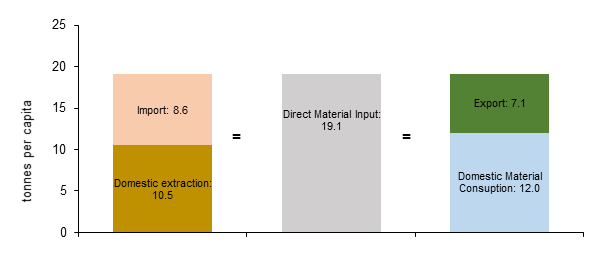Print
PDF
The amount of materials available in the SR and their utilization (the relationship between domestic extraction, DMI, DMC, import and export), year 2021, tonnes/capita.

Domestic material consumption
Last update of indicator24.01.2024
Indicator definition
The indicator describes the development of domestic material consumption (DMC) by material groups. It indicates whether materials are used efficiently during their life cycle.
Related policy documents and targets
The need to increase the efficiency of material converting into economic output and reducing the environmental load per unit of economic performance is highlighted in the EU Sustainable Development Strategy, the EU thematic strategy for the sustainable use of natural resources and Recommendation of the OECD Council on material flows and resource productivity. They are not currently included in any strategic documents of SR.
Key question
What is the development of domestic material consumption?Key messages
- Domestic material consumption (DMC) in 2021 reached a value of 65 585 thousand tons, which is 12.0 tons per capita. In the period from 2005 to 2021, a decrease of DMC per capita by approx. 14% was recorded.
| Change since 2005 | Change since 2015 | Last year-on-year change |
|---|---|---|
 |
 |
 |
| Since 2005, there has been a decline in domestic material consumption. | Since 2015, domestic material consumption has decreased slightly. | Compared to the previous year, there was a slight increase in domestic material consumption. |
Summary assessment
Detailed assessment
Domestic extraction (mineral raw materials and biomass) plus imports represent direct material input (DMI) into the economy. The total amount of materials directly used within the national economy is tracked by domestic material consumption (DMC), which is calculated as direct material input minus exports. In 2021, DMC in the Slovak Republic was 65 585 thousand tons, which represents 12.0 tons per capita (the average value within the EU states was 14.4 tons per capita). In the period from 2005 to 2021, a decrease in DMC per capita was recorded by about 14%. In 2021, domestic extraction for the Slovak Republic was 10.5 tons per capita, while the average value within the EU was 12.4 tons per capita. The import of goods was 8.6 tons per capita. Direct material input (DMI) was 19.1 tons per capita (the average value within the EU states was 16.1 tons per capita). Domestic material consumption (DMC) was 12.0 tons per capita (the average value within the EU states was 14.4 tons per capita).
The amount of materials available in the SR and their utilization (the relationship between domestic extraction, DMI, DMC, import and export), year 2021, tonnes/capita.

Source: Eurostat
A more detailed view at the composition of DMC provides an impression of the importance of various materials and their possible potential for their recovery. In 2021, DMC in Slovakia consisted mainly of non-metallic minerals (49.8%), followed by biomass with 26.6%, of fossil energy materials (17.4%) and metal ores with 6.2%.
A more detailed view at the composition of DMC provides an impression of the importance of various materials and their possible potential for their recovery. In 2021, DMC in Slovakia consisted mainly of non-metallic minerals (49.8%), followed by biomass with 26.6%, of fossil energy materials (17.4%) and metal ores with 6.2%.
The size of the share of imports in DMC also has an important explanatory power. The larger the ratio of this share, the more sensitive the economy of a given state is to random fluctuations in foreign trade (a shortage of certain commodities, an unexpected increase in their prices, etc.). The share of imports in DMC increased from 50.3% in 2005 to 71.8% in 2021, which means an increasing degree of dependence of the Slovak economy on the import of raw materials.
International comparison
Eurostat: Domestic material consumption